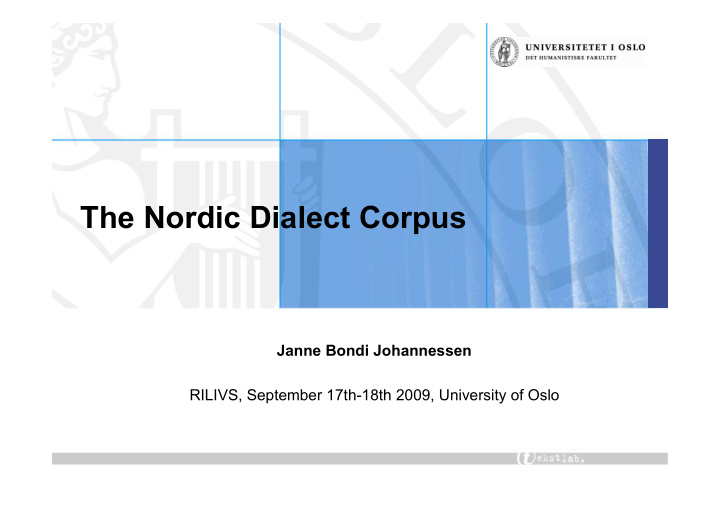



The Nordic Dialect Corpus Janne Bondi Johannessen RILIVS, September 17th-18th 2009, University of Oslo
Credits • Collaboration – The research network ScanDiaSyn and the Nordic Centre of Excellence in Microcomparative Syntax (NORMS) • Financing of linguistic contents – National research councils an universities in the individual countries • Financing of technical development – University of Oslo, – The Norwegian Research Council – Nordic research funds NOS-HS and NordForsk
Why the Nordic Dialect Corpus was developed • Initiated by members of Nordic Centre of Excellence in Microcomparative Syntax and the ScanDiaSyn network • Overarching goal: to study the dialects of the North- Germanic dialect continuum – The Nordic languages are closely related and have some mutually intelligibility – Studying the dialects within each national language is misguided from a theoretical and principled point of view – Difficult for each researcher to get hold of relevant data on their own in such a large area. – Many different kinds of data needed for syntax research
Two research tools • Nordic Dialect Corpus • Nordic Syntactic Judgment Database
Corpus features • Linguistic contents – Dialects from five closely related languages • Annotation – POS tagging and two types of transcription • Search interface – Advanced possibility to combine an array of search criteria and results presentation in an intuitive interface • Many search variables – Linguistics-based, informant-based, time-based • Multimedia display – Linking of sound and video to transcriptions • Display of informant details – Number of words and other informant information • Advanced results handling – Concordances, collocations, counts, statistics … • The corpus is available on the web
Linguistic contents and numbers • The corpus contains dialect data from the national languages Danish, Faroese, Icelandic, Norwegian, and Swedish • Contains speech data – app. 916 841words (by 10 September 2009) • Still growing quickly • All the recordings represent spontaneous speech • Differences in data collection due to differences in financing – Norwegian, Oevdalian, and some Danish: two kinds of recordings per informant: - semi-formal interview - informal conversation between two informants – Recordings of both young and old informants, both genders – Both new and old recordings – Audio or both audio and video recordings
Individual texts from • Danish – DanDiaSyn and NORMS • Faroese – NORMS field work and Nordforsk • Icelandic – Ásta Svavadottir, NORMS • Norwegian – NorDiaSyn, NORMS and Målførearkivet • Swedish – Swedia 2000, SweDiaSyn, NORMS field work and UiO
Contents by country and date Country No of words No of words May 2009 September 2009 Denmark 19 088 123 187 Faroes 22 207 48 427 Finland 0 0 Iceland 10 287 10 287 Norway 165 176 424 443 Sweden 304 421 310 497 Sum 521 179 916 841
Annotation: transcription • Each dialect has been transcribed by the standard official orthography of that country – In addition all the Norwegian dialects and some Swedish dialects have been transcribed phonetically • The Norwegian phonetic transcription – follows roughly that of Papazian and Helleland (2005). • The transcription of the Övdalian dialect follows the Övdalian orthography (standardised in 2005 by the Rå ð djärum – The Övdalian Language Council). – The phonetic transcription is translated to an orthographic transcription via a semi-automatic dialect transliterator
Annotation: tagging • The corpus will be POS tagged, with selected morpho-syntactic features language by language • Norwegian – POS tagged by a TreeTagger first developed for the Corpus of Oslo spoken Norwegian (Søfteland og Nøklestad 2008), and used unchanged for the dialect corpus. (Accuracy of 96.9%) • Swedish – A TnT POS tagger developed by Sofie Johansson-Kokkinakis (2003) for written Swedish is being used to tag the Swedish dialect data. The corrected result will be used to train a TreeTagger. • Icelandic – IceTagger available in the IceNLP toolkit (Hrafn Loftsson 2008)
Other dialect corpora? We know of no comparable resource for any language – Sounds familiar? Accents and Dialects of the UK • No grammatical search options • No results handling – The British National Corpus • No audio • Orthographic transcription • Unreliable dialect categories – The DynaSand dialect database • Few spontaneous utterances – The Spoken Dutch Corpus • Not web-based • Orthographic transcriptions • Not dialect data – The Scottish Corpus of Text and Speech • Not a dialect corpus • No searchable linguistic features – La phonologie du français contemporain (PFC) • Web-based dialect corpus with audio links • No grammatical annotation – Others under development: • Corpus of Estonian Dialects • Spoken Japanese Dialect Corpus – Paul Thompson at the University of Reading: Posting at Corpora List 30 Nov. 2008 about linked audio or video files with transcripts: 15 answers, of which only one on dialects: ours
Search interface – Glossa
Searching for lemmas
Searching for more than one word
Search results
Some results presented as frequency list
Searching for part of speech
Phonetic querying
Displaying results
Display of transcription and tagging
Informant-based querying
Display information on informants 1
Display information on informants 2
Action menu
Count
Deleting or selecting some results
Annotating results
Downloading results, examples: Excel: Tab separated values:
Saving results
• Nordic dialect corpus: http://www.tekstlab.uio.no/nota/scandiasyn/
References • Loftsson, H. 2008. Tagging Icelandic text: A linguistic rule-based approach. Nordic Journal of Linguistics 31:47-72. • La phonologie du français contemporain (PFC) . http://www.projet- pfc.net/index.php?option=com_wrapper&view=wrapp er&Itemid=184
Recommend
More recommend